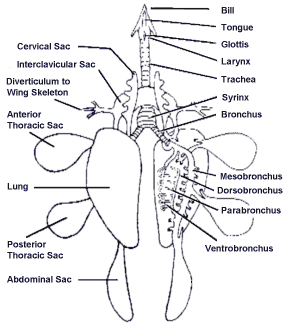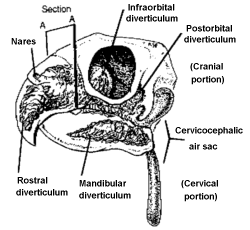Birds possess a very unique and efficient respiratory system. They lack a diaphragm, have nonexpandable lungs and a system of air sacs which extend into many of their bones. Vocalization is by means of a syrinx, not a larynx as in mammals.
This column will describe the structure of the avian respiratory system. The following article will cover common problems and diseases and why birds are so sensitive to chemicals.
 Anatomy
Anatomy
The nostrils or nares are usually located at the base of the beak. In psittacines (parrots) they are located within the area of the cere. Amazons have a structure known as an operculum inside the nare which helps prevent inhalation of foreign bodies. In most birds the nares are readily visible, while in certain birds – such as crows – they are covered by feathers.
Air enters the nares and moves in the nasal cavity. The nasal cavity is divided into a right and left side by a nasal septum. This septum is composed of cartilage and bone. Highly vascularized projections, nasal conchae, project from the lateral walls into the nasal cavity. Three nasal conchae – the rostral, middle and caudal – are present. These increase the surface over which inhaled air passes.
 A large sinus known as the infraorbital sinus, surrounds the eye and extends into the upper and lower beak. This sinus opens upwards (dorsally) into the middle and caudal nasal conchae. Because this sinus has a dorsal and not a ventral (downward) opening, it is very difficult for any infection of the infra orbital sinus to drain.
A large sinus known as the infraorbital sinus, surrounds the eye and extends into the upper and lower beak. This sinus opens upwards (dorsally) into the middle and caudal nasal conchae. Because this sinus has a dorsal and not a ventral (downward) opening, it is very difficult for any infection of the infra orbital sinus to drain.
The infraorbital sinus also communicates with the cervicocephalic air sac. This air sac is not a pulmonary air sac and extends along the neck and back of the skull.
The nasal cavity filters inhaled airborne particles by means of mucus and small hair-like cilia. These particles enter the nares and are directed by the cilia through the choana and are then swallowed. Inhaled air is warmed and moistened by the nasal cavity.
The larynx is at the entrance of the trachea. The opening of the larynx is the glottis. Birds differ from mammals in that the larynx does not have vocal chords and therefore is not involved in voice production. In addition, the small flap of tissue covering the glottis (the epiglottis) is not present.
The trachea is formed by a series of ring-shaped cartilages, which are completely closed in birds. In mammals the tracheal ring is not completely formed of cartilage, but contains a membranous component.
The trachea bifurcates (divides) after entering the thoracic cavity. The syrinx or voice box is located at this bifurcation.
The syrinx is composed of cartilage and vibrating soft structures; the largest is known as the tympanum. In some species – such as the domestic duck – the syrinx of the male has a dilitation or bulba on the left side.
The lungs are paired and are not divided into lobes as they are in mammals. They have very little ability to expand and are attached firmly to the ribs and dorsal body wall.
Birds do not have a diaphragm and therefore rely on pressure changes in their air sacs to move air through the lungs.
Most birds have eight air sacs. These air sacs act as a bellows system to move air through the respiratory tract. Many of these air saces extend into bones. These bones are described as being pneumatic bones.


 Anatomy
Anatomy